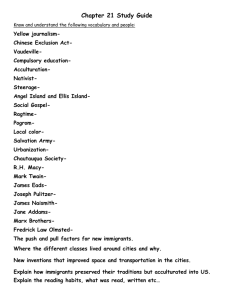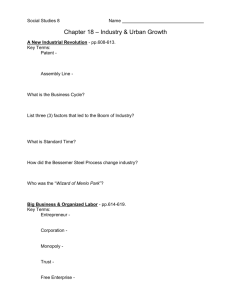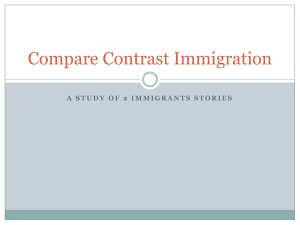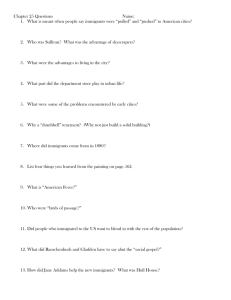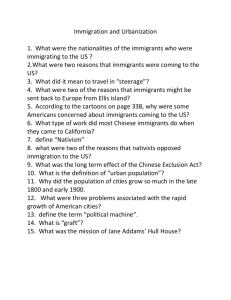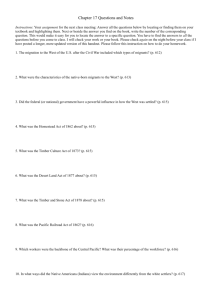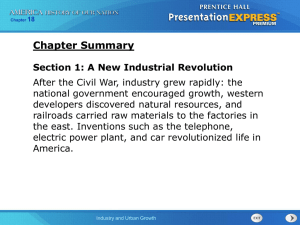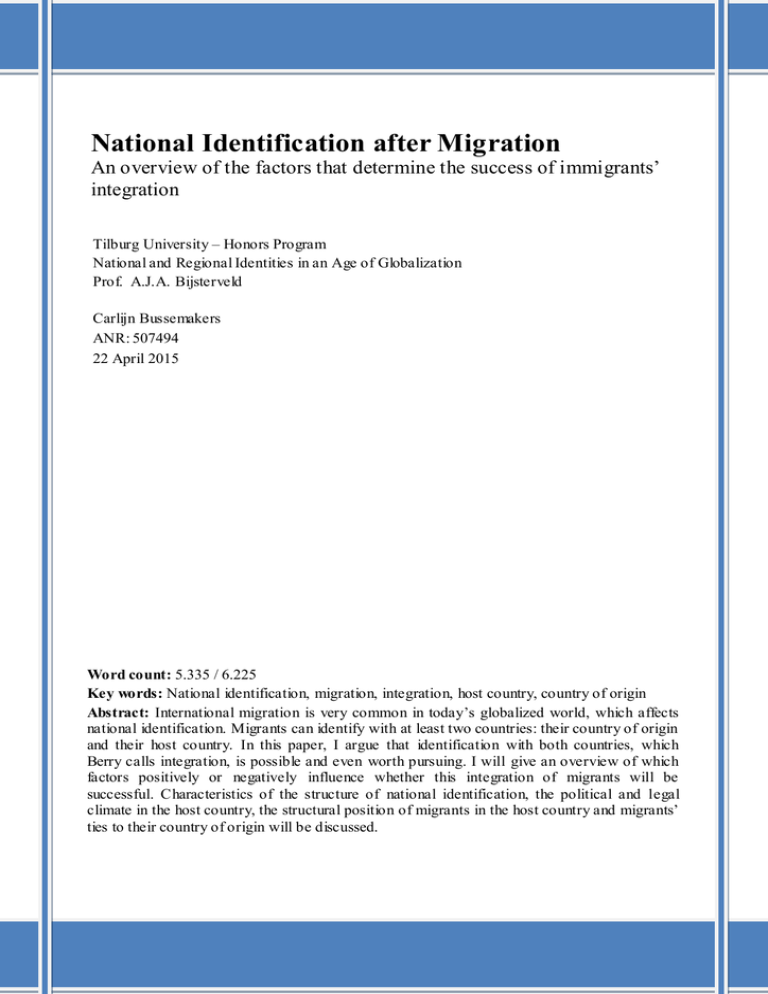
National Identification after Migration
An overview of the factors that determine the success of immigrants’
integration
Tilburg University – Honors Program
National and Regional Identities in an Age of Globalization
Prof. A.J.A. Bijsterveld
Carlijn Bussemakers
ANR: 507494
22 April 2015
Word count: 5.335 / 6.225
Key words: National identification, migration, integration, host country, country of origin
Abstract: International migration is very common in today’s globalized world, which affects
national identification. Migrants can identify with at least two countries: their country of origin
and their host country. In this paper, I argue that identification with both countries, which
Berry calls integration, is possible and even worth pursuing. I will give an overview of which
factors positively or negatively influence whether this integration of migrants will be
successful. Characteristics of the structure of national identification, the political and legal
climate in the host country, the structural position of migrants in the host country and migrants’
ties to their country of origin will be discussed.
Introduction
According to the United Nations, international migration is an intrinsic feature of
globalization (United Nations Department of Economic and Social Affairs, n.d.). In today’s
highly globalized world, international migration is very common: in 2013, there were 232
million international migrants worldwide (United Nations Department of Economic and
Social Affairs, 2013). This large number of migrants puts the question of integration and
identification high on the (inter)national political agenda. Receiving states expect newcomers
to be affirmative and loyal to their new home country (Kofman, 2005), which results in
policies for immigrants that are focused on assimilation to the culture of the host country
(Phiney et al., 2001; Wetenschappelijke Raad voor het Regeringsbeleid (WRR), 2007a).
Assimilation means that migrant’s identification with the country of origin is fully replaced by
identification with the host country: they have to choose the identity of their new home
country (Phiney et al.; WRR 2007a). In the Netherlands for example, the question of
integration became more and more a question of identification: national identification, in this
case identification with the host country, is seen as the only way to achieve national cohesion
and should be pursued by all immigrants living in the Netherlands (WRR, 2007b).
This policy seems to be on a very specific view on identification, namely that a
person can identify with only one country. However, there are several views on identification
allowing migrants to identify with both their country of origin and the host country, one of
which uses the concept of nested identities. Diéz-Medrano and Gutiérrez define this concept
in the following way: “Lower- and higher order identities such that the latter encompass the
former” (Diéz-Medrano & Gutiérrez, 2001 quoted in Bijsterveld & Halman, 2014a). This can
for example mean that someone identifies with the city he or she lives in, and therefore with
the country of which that city is part, instead of identifying with the either city or the country.
In the specific case of a migrant, it might mean that he or she identifies with the host country
on the higher level, and with the country of origin on the lower level in the sense that he or
she regards himself as being a citizen of the host country, and more specifically, member of
the subgroup of migrants from a certain country of origin who migrated to the host country.
Other visions on identification do allow for identification with multiple countries without this
hierarchical order, one of which is based on the ideas of Liebkind and Berry (Phinney et al.,
2001). It sees identification with a group or nation as “a subjective sense of belonging to a
group or culture” (Phinney, 1990:495), which allows for identification with multiple nations
because it is possible to feel a sense of belonging to multiple groups. Berry states that
migrant’s preservation of the heritage culture and their adaptation to the society they migrate
to can vary independently, which is confirmed by later research (Phinney et al., 2001). He
identifies four ways in which migrants can deal with these national identifications:
integration, assimilation, separation and marginalization. Integration, for which also the term
hybrid identity can be used (WRR, 2007a; Tourbeaux, 2012), means that one identifies with
both the country of origin and the host country, and an marginalization that one identifies with
neither of the two. Assimilation means that migrants only identify with their new home
country, separation that they identify with their country of origin only. A nested migrant
identity, as explained above, can be seen as a form of integration. Berry’s terminology will be
used in this paper, unless otherwise specified, so the term integration indicates identification
2
with both the country of origin and the host country, assimilation means identification w ith
the host country only etc.
The views of Berry and Phinney et al. are confirmed by the results of different surveys
on identification. The scientific Council for Government Policy in the Netherlands (WRR)
investigated identification among high school students in the Netherlands, France and Great
Britain. Students were asked to create a top-5 of identities they identified with. They
answered different types of identities, including national identities, sub- national identities,
supra-national identities, religious identities and other identities. The results show that many
migrant students (including both the first and the second generation) include the identity of
the host country and the identity of the country of origin in their identification top-5. This
shows that according to these students, it possible to identify with more than one country at
the same time. Furthermore, significant differences between countries were shown: of the
three groups of students, the Dutch students with a migrant background identified most with
the host country, followed by British students and French students with a migrant background
identified with the host country the least. These findings are supported by a study by Phinney
et al. (2001) among representative samples of migrants in the USA, Israel, Finland and the
Netherlands. Firstly, they confirmed that the two forms of national identification were often
compatible and that the distinction of Berry’s four types of acculturation could indeed be
made. Secondly, they found large differences in the acculturation strategies of migrants
between the four countries, which they attributed to contextual influences. These include for
instance the way immigrants are treated in a country and cultural differences between the
country of origin and the host country.
So it seems that identification with both the country of origin and the host country is
possible, and that contextual factors play an important role in whether migrants actually
identify with both. However, an overview of which factors have a positive or negative
influence on the success of integration lacks. In this paper, I will try to provide this overview
by taking different factors into account, including the way national identification in a country
is structured, the political- legal climate in a country, the structural position of migrants and
their ties to their country of origin.
The way national identification is structured
The way the identity of a country is structured has a great influence on whether a migrant can
easily identify with it, which is the case for both identification with the country of origin and
with the host country (WRR, 2007a). Different aspects of national identification and how they
influence whether migrants can successfully identify with a country will be discussed here.
Emphasizing the history people share has been an important factor in nation building
in western Europe, which often went hand in hand with abusing history and historical cherry
picking (Bijsterveld & Halman, 2014b). Today, especially in Europe, national identification is
still largely based on this shared history and history education plays an important role in
strengthening identification with the country among both the native and the migrant
population (WRR, 2007a). However, according to the Scientific Council for Government
Policy in the Netherlands, it is not possible to maintain this form of national identification,
3
since it does not appeal to an increasing share of the youth (WRR, 2007). This is true for both
immigrants, who do not share this particular history, and for the native youths, who are not
interested in the history of their country themselves and see that many are excluded from this
sense of shared history. Instead of a form of national identification that excludes the
immigrant share of the population, a form of national identification which unites
characteristics of the whole population is proposed (Faist, 2000; WRR 2007a). A way to
achieve this is to increase the diversity of national holidays: when not only Christian
celebrations and days that are important from a national historical perspective have the status
of a national holiday, but days that are important for other religions (such as the Islamic Eid)
and memorial days from an international historical perspective (such as the day slavery was
abolished) as well, immigrants are more likely to feel that their cultural background is equally
important for the nation as a whole, which in its turn increases identification with the nation
among them. This kind of integration of different histories and cultural backgrounds is very
common in the so called classical immigration countries, including the USA, Canada,
Australia, Israel and New-Zealand (Martin, 2002). Historically, these societies are formed by
large groups of people from many different countries who moved to these areas. This history
of immigration became an important aspect of the national identification in these countries,
and holidays and customs that originate from the country of origin of only a relatively small
part of the population are nowadays celebrated and or adopted by large shares of the
population (Jiménez, 2011). Examples of this are the originally Irish holiday St. Patrick’s day,
which is nowadays celebrated in both Australia and the USA by people without Irish
ancestors as well (Kennedy, 2015; Little, 2015), and the Dutch theme parks in the USA which
are visited by people from all over the world (see for instance Nelis’ Dutch Village in
Holland, Michigan or Dutch Wonderland in Lancaster, Pennsylvania). Although these are still
symbols of Irish and Dutch pride, it is an important uniting force in these countries because
they contribute to the acknowledgement of the many cultural backgrounds of civilians and
how they formed the nation it is today. This increases integration, and can contribute to the
formation of nested identities.
Besides sharing a history, national identification is also often based on sharing a
culture and values with others who live in the same country (Bijsterveld & Halman, 2014b).
According to Kofman immigrants commonly migrate to those countries in which the “us of
the dominant group is formulated around its tolerance and adherence to human rights
compared to the intolerant other” (2005: 462). To integrate in these countries, immigrants
have to accept the liberal values of the host country at the expense of the cultural values of
their own country of origin, which are generally regarded as inferior by the society of the host
country (Kofman, 2005). This is particularly problematic when the cultural distance between
the host country and the country of origin is large (Brimelow, 1995; Phinney et al., 2001;
WRR, 2007a; Langevin & Vincent, 2013). When that the case, migrants are expected to
change their whole value system in order to fit in the society of the host country (Phinney et
al., 2001; WRR, 2007a). It is questionable whether accepting such different values is even
possible, since values are formed by socialization during childhood and adolescence and
relatively stable later in one’s life (Inglehart, 1981). Even if one can change his or her values
and beliefs, it is not likely to happen as result of being forced to do so, but through a long and
intensive progress of living in a certain society and realizing the positive aspects of its norms
4
and values. Moreover, the idea that the cultural values of the host country are not only
different from, but superior to the values common in the countries migrants come from
divides society into two groups: those accepting the ‘superior’ values of the host country and
those who do not (Phinney et al., 2001; Kofman, 2005; WRR, 2007a). This impedes the
integration of migrants who typically have a different cultural background, and therefore often
different value systems.
Integration is of course not only dependent on the structure of host-country
identification, but also on the way identification with country of origin is structured. When
national identification in the country origin is strongly based on a shared history, it is much
more likely that migrants keep identifying with their country of origin, since they share that
history even after their emigration. The same can be said about forms of national
identification that are strongly based on shared values, but of course that is only the case if the
value system of migrant’s does not change drastically after migration. Identification with the
country of origin might be more likely when the cultural distance between the country of
origin and the host country is relatively small, because that makes it easier for migrants to
continue a value based identification with the country of origin.
The legal and political climate in a country
Some authors attribute a great influence to the legal climate (concerning migration) in the ho st
country on whether the integration of migrants will be successful (Faist, 2000; McLaren,
2001; Kofman, 2006). Three aspects of this climate will be discussed here, the first of which
is whether a country has a strict immigration policy or not. According to Brochmann “having
heavy restrictions on immigration could be interpreted as official authorization of the
insider/outsider “us/them” thinking, which contributes to worsening the climate rather than
alleviating the relations between already established immigrants and nationals” (Brochmann,
1996 quoted in McLaren, 2001: 84). The idea is that the strict immigration policy, strict in the
sense that few immigrants are allowed to come in, serves as a confirmation of the division in
society between the native population that is entitled to live in the country and the migrant
population. The migrants will feel that they are not welcome in the country and are not
accepted as part of the nation. This decreases identification with the host country among
them, in the same way the division based on value differences does (see the previous chapter).
The consequence of this would be that people living in countries that are part of the Schenge n
area 1 are accepting immigrants from other countries that are part of this area much more
warmly than immigrants from other countries. Thränhardt and Miles (1995, quoted in
McLaren, 2001: 85) argue that this is indeed the case: “… within Europe, there is now a
widely held view of cultural closeness and similarity between all the “nations” of Western
Europe” which leads to a higher level of acceptance of European immigrants. However,
findings from McLaren (2001) contradict this. She shows that most European citizens regard
European immigrants the same as non-European immigrants, indicating that they do not feel a
special closeness towards other Europeans or welcome immigrants from other Schengen
1
The Schengen area is consists a number of European countries (both EU and non-EU) and allows the free
movement of persons between these countries, without special formalities (Eu ropean Co mmission, 2015).
5
countries more warmly. This indicates that a country’s migration policy does not heavily
influence migrants’ integration through strengthening us/them- thinking.
The second aspect of the legal climate concerning migration is whether countries
actively stimulated multiculturalism or not. Host country governments can stimulate
multiculturalism by allowing migrants to maintain their own language and culture for
example (Phinney et al., 2001), or promoting cultural diversity through giving a wide variety
of days, in the sense of days that are important for people with different cultural bakcgrounds,
the status of national holiday (Faist, 2000). When governments do so, it is expected to lead to
higher levels of integration or separation among migrants, and lower levels of assimilation.
However, the findings of the study by Phinnet et al. (2001) do not support this idea. In the
countries in which the government stimulated multiculturalism, immigrants were not more
likely to identify with both the host country and the country of origin. This relationship was
only found in California, where multiculturalism is promoted by different policies and
immigrants are more likely to identify with both the USA and their country of origin. So it
seems that the host country laws on immigratio n and integration are not determinative in
whether immigrants will successfully integrate or not.
However, the political climate in country does have an important effect on this. When
politicians constantly emphasize that immigrants are different from the nat ive population,
immigrants are much less likely to integrate (Phinney et al., 2001; Kofman, 2005; WRR,
2007a). In the Netherlands for instance, the fact that many immigrants are Muslim and
therefore different than the ‘Dutch’ native population is heavily emphasized by right
politicians like Geert Wilders (WRR, 2007a). The results of the study among high school
students mentioned in the introductions shows that this emphasis on the difference between
immigrants and non- immigrants decreases identification with the host country among the
immigrant youth, and increases their religious identification (among those that are Muslim or
of another, non-Christian or Jewish faith) and identification with their country of origin
(among all immigrant students) (WRR, 2007a). The idea behind this is twofold. Firstly,
statements of these kind are made by popular politicians, whose ideas reflect the ideas of a
large share of the population. The fact that many people agree with the idea that immigrants
are different from the native population makes integration of the immigrants much less likely,
as was explained earlier with respect to value based identification and the cultural distance
between the host country and the country of origin. Secondly, politicians do not only
represent their voters, but the government of the host country as well. This strengthens the
division in society and the idea that they are not welcome in the country among migrants. The
effect of this kind of statements by politicians is likely to be greater than the effect of actual
immigrations laws, because many people might not be aware of the exact immigration policy
of their country. These statements on the other hand are well known by many people because
they receive ample attention from the media (see for example Joop.nl, 2015; NRC, 2015;
Telegraaf, 2015).
It has to be noted that Phinney et al. (2001) argue that a negative view on the culture
and identity of migrants in the general society can also have two opposing effects. Their ideas
are based on social identity theory, which states that people identify with certain groups they
belong to and that this belonging is an important source of well-being and a high self-esteem
(Tjafel & Turner, 1979). Because people want to maintain a positive view on the group they
6
belong to, a negative view on the culture of migrants in the general society could lead to
higher levels of assimilation among migrants. This is the case belonging to a group which is
looked down upon can decrease one’s well-being and self-esteem (Tjafel & Turner, 1979).
On the other hand, a negative view in the general society does not necessarily mean that
migrants also share this view. If they have a positive view on the migrant group, they will
maintain their identification with it. However, it does make integration much difficult, so of
this is the case, separation is more likely among immigrants than integration (Phinney et al.,
2001).
The structural position of migrants in society
Furthermore, multiple authors argue that the structural position of migrants largely influences
whether they successfully integrate in the host country or not (Faist, 2000; Kofman, 2005;
Tourbeaux, J., 2012). According to them, integration is only possible when migrants have
equal opportunities as the native population: when that is not the case, they are more likely to
regard themselves as secondary citizens in the host society, which decreases identification
with the host country among them. This is confirmed by Tourbeaux (2012), whose research
demonstrates that upward social mobility goes hand in hand with what he calls a ‘hybrid
cultural identity’: (descendants from) immigrants combine values from the country of origin
and the host country. Furthermore, there is also evidence for an indirect relation between
migrants structural position and integration. Findings by Phinney et al. (2001) show that wellbeing is positively related to assimilation and integration, indicating that immigrants who are
satisfied with their lives are more likely to identify with the host country. Well-being in its
turn is strongly related to a higher socioeconomic status, which can only be achieved by
migrants if they have equal opportunities at school, the job market etc. as non- migrants
(Pinquart & Sörensen, 2000). Two sociological theories deserve some extra attention in the
context of migrant’s structural position and identification, namely conflict theory, which
argues that a better structural position of migrants would lead to more conflict and less
identification, and contact theory, which argues the opposite.
Conflict theory is based on Marx’s vision on society, which is the idea that different
groups in society compete for scarce economic and social resources (Wallace & Wolfa, 2006;
Crossman, 2015). Whereas Marx thought that society was divided into different groups based
on differences in economic power only, sociologists nowadays argue that society is also
divided across the lines of culture, gender, religion etc. (Wallace & Wolf, 2006a; Crossman,
2015). In this light, immigrants and natives can in certain situations also be seen as two
competing groups in society. Between 1960 and 1980, guest workers were very common in
Western European countries (Andere Tijden, 2010). Because of a shortage of low-skilled
workers, governments actively brought immigrants from southern Europea n and NorthAfrican countries to temporary work in their country (Andere Tijden, 2010). In that specific
situation, the guest workers and the native population are two different groups in society, but
they are non-competing: they do not strive after the same jobs etc. 2 However, when
2
Both governments and the guest workers themselves had the idea that they would only temporary wo rk in the
host country (Andere Tijden, 2010). Therefore, govern ments did not actively stimulate integration among them:
7
immigrants get equal opportunities as non- migrants in the sense that they can get an education
and develop themselves which allows them to apply for jobs with a higher status and improve
their structural position, the two groups become competing groups. The native population
will perceive the immigrants as thread and it will develop a negative perception of the them
(Wallace & Wolf, 2006). ‘Us vs. them’-thinking will increase and the native population will
start to develop ways to protect their own interest. The rise of right-wing, anti- immigrant
political parties can be seen as a result of this competition: the native population feels
threatened and wants to protect itself by reducing the number of immigrants in society and
emphasize that the immigrants are different from them. As explained earlier, this decreases
integration among the immigrant population. So, from a conflict-theoretical perspective,
increasing the opportunities and socioeconomic status of migrants would have a negative
impact on migrants’ integration.
However, contact theory argues that this not the case. Contact theory is based on ideas
of Allport, who argues that structural contact between members from different groups
decreases prejudice and intergroup conflict (Wallace & Wolf, 2006b; Everett, 2013). Studies
on this relationship show that contact between groups, independent of whether members of
the different groups are equal in status are not, reduces explicit and implicit prejudice, the idea
that the own group is ‘good’ and the other group ‘bad’ and the perceived intergroup conflict
(Everett, 2013). Furthermore, the WRR explains how identification is also a relational
progress: through interpersonal contact, people are more likely to regard each other as
belonging to the same group, which increases identification with a group they both belong to,
which can be the country, but for instance a sports club (WRR, 2007a). Increasing migrant’s
opportunities and socioeconomic status is likely to lead to higher levels of intergroup contact:
nowadays they are overrepresented in lower-paid jobs, poorer neighborhoods and so-called
black schools where they mainly have contact with other immigrants (Phinney et al., 2001;
WRR, 2007a; Vink, 2012). When this changes, they are more likely to meet non- migrants at
the workplace, in the neighborhood and at school, which increases identification with nonmigrants, and therefore, the host country (WRR, 2007a). This idea also allows for a different
interpretation of the findings by Phinney et al. (2001) discussed earlier. It could be the case
that higher well-being among immigrants leads to higher levels of identification with the host
country because higher levels of well-being are strongly related to higher levels of intergroup
contact (Sarracino, 2014), instead of a higher socioeconomic status per se. However in both
cases, a better structural position for migrants would lead to higher levels of integration.
Migrants’ ties to their country of origin
Because integration defined as identifying with both the country of origin and the host
country, migrants’ ties to their country of origin also have to be taken into account. Two
aspects of these ties will be shortly discussed here, namely contact with people in the country
of origin and having the nationality of the country of origin. Earlier, the relationship between
contact with the native population and identifying with the host country was explained. This
guest workers did not have to learn the language country etc., which made that they did not form a threat for the
native population.
8
mechanism can also be applied to identification with the country of origin: identification with
that country will increase when migrants frequently contact friends and family who still live
there (Phinney et al., 2001; WRR, 2007a). In that way, strong ties to people in the country of
origin can increase integration among immigrants (compared to assimilation). Nowadays, this
kind of contact is much easier maintained than it was a few decades ago, because modern
technology allows people to contact other’s around the world at relatively low costs – think
for example about Skype and the low cost air carriers (WRR, 2007a). Future technology
might create new ways to establish and maintain these types of contact, which in its turn can
increase integration even more.
The second form of ties with the country of origin is a more formal one: having the
nationality of the country origin. Faist (2000) argues that having a country’s nationality makes
people feel that they are officially part of that nation, which increases identification with a
country. This effect is stronger when the government of the country of origin emphasizes this
connection to citizens of their country who live elsewhere, and provides ways for them to
participate somehow in the society of their country of origin. In 2014, the Turkish government
allowed the 1,5 million Turks who live in Germany to vote in the Turkish national elections
(Duitsland Instituut Amsterdam, 2014a; Statistisches Bundesambt, 2015). The Turkish prime
minister Erdogan even traveled to Berlin for an election campaign (Duitsland Instituut
Amsterdam, 2014a). Although the turnout among the German Turks was relatively low, it is
likely to have increased identification with Turkey among those who already felt some
connection to Turkey and were interested in Turkish politics (Duitsland Instituut Amsterdam,
2014b). So, to increase integration among immigrants, countries could allow emigrants to
keep their original nationality. Furthermore, the same could be said for the host country: when
immigrants have the nationality of the host country, they are more likely to identify with it.
To increase integration among its migrants, host countries could therefore choose to allow
immigrants to have multiple nationalities.
Conclusion
Nowadays, immigrant policy is to a large extent focused on national identification and based
on the idea that people can identify with only one country at the same time (Phinney et al.,
2001; Kofman, 2005; WRR, 2007a). This results in policies demanding that immigrants
replace their identification with their country of origin with identification with their host
country. in order to become a full member of their new home country’s society (WRR,
2007b). However, there are two problems with this view on migration and identification. First
of all, the idea that people can identify with only country seems far from the truth. Many
authors describe ways in which people can identify with multiple countries (nested identities,
hybrid identities and Berry’s integration for example) and studies show how a stronger
identification with one country does not necessarily means weaker identification with another
(Phinney et al., 2001; WRR, 2007a). Therefore, when the government of a certain country
wants to increase identification with that country among immigrants, it does not need to focus
on decreasing identification with the country of origin among them. Secondly, it is
questionable whether immigrants can always choose to identify with the host country. Often,
9
national identification is based on things that immigrants cannot easily relate to, for instance a
shared history, or that explicitly emphasize that one country is different or even better than
other countries, like liberal values. When that is the case, there is little room for the culture,
history etc. of migrants in a nation’s identity, which makes it much more difficult for
immigrants to identify with that country. Therefore, I recommend governments of countries
with many migrants to focus on what Berry calls integration: enabling immigrants to identify
with both their country of origin and the host country (Phinney et al., 2001). Another
advantage of this approach is that integration is strongly related to higher levels of well-being
among immigrant’s, and therefore increases the general happiness in a country (Phinney et al.,
2001), and might lead to more tolerance and respect and less conflict between immigrants and
the native population.
Different characteristics of the host country influence whether this type of integration
will be successful, namely the way a national identification is structured, the political climate
in a country and the structural position of migrants in a society. When a nation’s identification
is largely structured around a shared history, integration could be strengthened by giving more
attention to historical moments that are important from an international perspective, and
emphasizing the contribution of migrants to a country. This can for instance be done by
making national holidays more culturally diverse (Faist, 2000; WRR, 2007a). When a
country’s national identification is largely structured around certain values, the idea that the
values of that nation are superior to the values of the countries immigrants come from is likely
to reduce integration (Kofman, 2005; WRR, 2997a). Furthermore, forcing immigrants to
accept the values of the host country, if that is even possible, is also not likely to have positive
effects (Inglehart, 1981). A large cultural distance between a country of origin and a host
country could instead be bridged through increasing contact between different immigrant
groups and the native population and by promoting tolerance and respect for people with
different values (Wallace & Wolf, 2006b; Everett, 2013). Furthermore, it became clear that
the legal climate in a country does not have strong direct effect on integration, but that the
political climate does. If politicians want to increase integration of immigrants, they should
stop emphasizing the differences between immigrants and the native population and/or
publically object this type of statements. Finally, integration could be increased by improving
the structural position of migrants in society. Different studies reject the conflict-theoretical
idea that a better socioeconomic position for immigrants leads to more competition between
the native population and immigrants, which reduces integration (Phinney et al., 2001;
Tourbeaux, 2012). The contrary is true: when immigrants and the native population have
equal opportunities and immigrants are upwardly mobile, they are more likely to integrate.
This can be caused by either the higher socioeconomic status itself, or by the fact that it
increases contact between the immigrants and the native population. However, increasing
contact between these groups and provide equal opportunities to immigrants are likely to be
strongly related and form good strategies to increase integration among migrants.
Besides identification with the host country, identification with the country of origin is
also part of integration. Two characteristics of the country of origin are likely to increase
identification with that country after migration, namely the structure of the national
identification and migrants’ ties to their country of origin (Phinney et al., 2001; WRR, 2007a).
Especially when the national identification is structured around a shared history, emigrants are
10
likely to keep identifying with that country. When national identification is based on cultural
factors, such as a certain religion or set values, emigrants might also keep identifying with the
country after migration, but whether that is the case depends on whether their values and/or
religious orientations change. Furthermore, it became clear that strong ties to their country of
origin increases migrants’ identification with that country. The ties can consists of informal
contact with friends and family who still live in the country, but more official types are also
possible. By facilitating these formal ties, for instance though allowing emigrants to maintain
their nationality or even vote for national elections, the government of the country of origin
can increase identification with the country among emigrants.
References
Andere Tijden (2010). Gastarbeiders: hoe meer, hoe beter! NPO Geschiedenis. Retrieved
April 19, 2015 from http://www.npogeschiedenis.nl/andere-tijden/afleveringen/20102011/Gastarbeiders- hoe- meer- hoe-beter.html.
Bijsterveld, A.J.A. & Halman, L.C.J.M. (2014a). 6. European Identity or back to the Middle
Ages? [PowerPoint slides]. In Lecture Series Theme: National and Regional Identities
(2013/2014).
Bijsterveld, A.J.A. & Halman, L.C.J.M. (2014b). 3. Nationalism [PowerPoint slides]. In
Lecture Series Theme: National and Regional Identities (2013/2014).
Brimelow, P. (1995). Alien nation: common sense about America's immigration disaster. New
York: Random House.
Crossman, A. (2015). Conflict Theory. Sociological Theory. Retrieved April 19, 2015 from
http://sociology.about.com/od/Sociological- Theory/a/Conflict-Theory.htm.
Duitsland Instituut Amsterdam (2014a). Premier Erdogan vraagt in Berlijn om stemmen
Duitse Turken. Kort nieuws. Retrieved April 21, 2015 from http://duitslandinstituut.nl
/artikel/4370/premier-erdogan-vraagt- in-berlijn-om-stemmen-duitse-turken.
Duitsland Instituut Amsterdam (2014b). Meeste stemmen in Duitse steden voor Erdogan,
maar opkomst laag. Kort nieuws. Retrieved April 21, 2015 from http://
duitslandinstituut.nl/artikel/4926/meeste-stemmen- in-duitse-steden-voor-erdoganmaar-opkomst- laag.
European Commission (2015). Schengen Area. Migration and Home Affairs. Retrieved April
15, 2015 from http://ec.europa.eu/dgs/home-affairs/what-we-do/policies/borders-andvisas/schengen/index_en.htm.
Everett, J.A.C. (2013). Intergroup Contact Theory: Past, Present, and Future. The Inquisitive
Mind, 2 (17), published online. Retrieved April 19, 2015 from http://www.inmind.org/article
/intergroup-contact-theory-past-present-and- future?.
Faist, T. (2000). Transnationalization in international migration: implications for the study of
citizenship and culture. Ethnic and racial studies, 23(2), 189-222.
Inglehart, R. (1981). Post-Materialism in an Environment of Insecurity. The American
Political Science eview, 75 (4), 880-900.
Jiménez, T.R. (2011). Immigrants in the United States: How Well Are They Integrating into
Society? MPI Reports. Retrieved May 12, 2015 from: http://www.migrationpolicy.org/
research/immigrants-united-states-how-well-are-they- integrating-society.
Joop.nl (2015). Felle botsing Wilders en de Kamer in debat aanslagen Parijs. Politiek.
Retrieved April 15, 2015 from: http://www.joop.nl/politiek/detail/artikel/30364_felle_
botsing_wilders_en_de_kamer_in_debat_aanslagen_parijs/.
11
Kennedy, E. (2015). Are you celebrating St. Patrick’s Day the American way or the Irish
way? The Washington Times 15-03-2015. Retrieved May 4, 2015 from http://www.
washingtontimes.com/news/2015/mar/15/st-patricks-day- in- ireland-has-differencesfrom-am/?page=all.
Kofman, E. (2005). Citizenship, Migration and the Reassertion of National Identity.
Citizenship Studies, 9 (5), 453-467.
Langevin, G. & Vincent, P. (2013). National Identity and Immigrants’ Assimilation in France.
Economics Working Paper Archive , 201341.
Little, B. (2015). How America (Not Ireland) Made St. Patrick’s Day as We Know It.
National Geographic 16-03-2015. Retrieved May 4, 2015 from http://news.
nationalgeographic.com/2015/03/150316-st-patricks-day- ireland- irish-holiday-nation/.
Martin, P.L. (2002). Immigration in the United States. Working Paper CIIP-2. Retrieved
April 15, 2015 from: http://ies.berkeley.edu/pubs/workingpapers/ciip-2-plm_
united_states.pdf.
McLaren, L.M. (2001). Immigration and the new politics of inclusion and exclusion in the
European Union: The effect of elites and the EU on individual- level opinions
regarding European and non-European immigrants. European Journal of Political
Research, 39, 81-108.
NRC (2015). Perfect Duits, weinig spetterende speech – de Duitse media over Wilders.
Nieuws. Retrieved April 15, 2015 from: http://www.nrc.nl/nieuws/2015/04/14/perfectduits-weinig- spetterende-speech- zo-schrijven-de-duitse-media-over-wilders/.
Phinney, J.S. (1990). Ethnic identity in adolescents and adults: A review of research.
Psychological Bulletin,108, 499-514.
Phinney, J.S., Horenczyk, G., Liebkind, K. & Vedder, P. (2001). Ethnic Identity,
Immigration, and Well- Being: An Interactional Perspective. Journal of Social Issues,
57 (3), 493-510.
Pinquart, M. & Sörensen, S. (2000). Influences of socioeconomic status, social network, and
competence on subjective well-being in later life: A meta-analysis. Psychology and
Aging, 15 (2), 187-224.
Sarracino, F. (2014). Richer in Money, Poorer in Relationships and Unhappy? Time Series
Comparisons of Social Capital and Well- Being in Luxembourg. Social Indicators
Research, 115 (2), 561-622.
Statistisches Bundesambt (2015). Ausländische Bevölkerung 2008 bis 20141 nach
ausgewählten Staatsangehörigkeiten. Ausländische Bevölkerung. Retrieved April 21,
2015 from https://www.destatis.de/DE/ZahlenFakten/GesellschaftStaat/Bevoelkerung/
MigrationIntegration/AuslaendischeBevolkerung/Tabellen/StaatsangehoerigkeitJahre.
html.
Telegraaf (2015). Wilders jut Duits publiek op. Vandaag in beeld. Retrieved April 15, 2015
from http://www.telegraaf.nl/tv/nieuws/binnenland/23919734/__Wilders_jut_
Duits_publiek_op_ _.html.
Tajfel, H., & Turner, J. C. (1979). An integrative theory of intergroup conflict. The social
psychology of intergroup relations, 74, 33-47.
Tourbeaux, J. (2012). L’integration des Portugais du Luxembourg. Archives Europeennes de
Sociologie, 53 (2), 235-262.
United Nations Department of Economic and Social Affairs (n.d.). International Migration.
Population Division. Retrieved April 3, 2015 from http://www.un.org/en/development
/desa/population/theme/international- migration/.
United Nations Department of Economic and Social Affairs (2013). The number of
international migrants worldwide reaches 232 million. Population Facts, 2013/2.
Retrieved April 3, 2015 from http://esa.un.org/unmigration/documents/The_number_
12
of_international_migrants.pdf.
Vink, A. (2012). Zwarte zwanen, witte zwanen: kansarme leerlingen en de mythe van de
zwarte school. Amsterdam: Meulenhoff.
Wallace, R.A. & Wolf, A. (2006a). Conflict Theory. Contemporary Sociological Theory (
sixth edition). New Jersey: Pearson Prentice Hall.
Wallace, R.A. & Wolf, A. (2006b). Evolution and Modernity: Macrosociological
Perspectives. Contemporary Sociological Theory (sixth edition). New Jersey: Pearson
Prentice Hall.
WRR (2007a). Nationale Identiteit en meervoudig verleden. Verkenningen. Amsterdam:
Amsterdam University Press.
WRR (2007b). Identificatie met Nederland. Rapporten aan de regering, 79. Den
Haag/Amsterdam: Amsterdam University Press.
13

